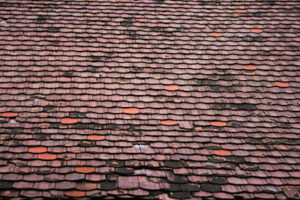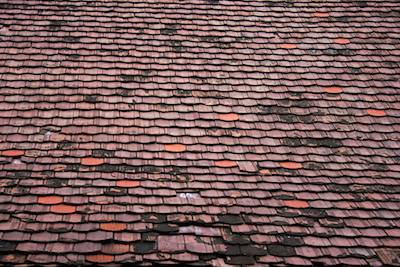What happens when a novice driver gets a car or truck and never changes the oil? Eventually he or she will “blow the engine”. It is well known that a vehicle requires regular maintenance to maximize its life. Less well known is that a roof requires periodic maintenance to maximize its life as well.
Roofs, like everything else in Creation, fall apart or age. Continuing with the

automobile analogy, eventually the cost of repair for a vehicle becomes so great that further repair expense is not justifiable. Any new money should bedirected toward a new vehicle. Roofs are no different. The trick is to do regular maintenance and small repairs to prevent, or at least delay, the inevitable day when a new roof must again be considered.
The average cost of a new roof (at least in Rutherford County, TN) is comparable to the cost of a good used car – most homeowners can expect to pay $7000 – $15000, for either. That’s a lot of money. Furthermore, roofs and vehicles depreciate in time. If something cost a lot to replace and it loses value yearly, it only makes sense to delay its replacement. We change our vehicles oil, belts, hoses, and a hundred other parts to extend its life, but what “parts” of our roofs need repair and maintenance? How do we avoid “blowing the engine”?
Before I discuss roof maintenance in detail, I would like to make three points that are relevant to the discussion. In spite of any efforts you may undertake, your roofs life will be limited by:
1.The quality of the materials that comprise your roof system (This also includes the ventilation system).
2. The expertise and the integrity of the installer (One without the other can lead to serious roof deficiencies).
3. The orientation of your roof (Both the slopes pitches and southern exposure).
Briefly, cheap or defective shingles, poor ventilation, thin sheet metal, etc. will, by their design, be limiting factors in your roof’s life expectancy. Cutting corners or purposefully using less than ideal materials or lacking the expertise to properly roof a difficult situation will also limit your roof’s life. Lastly, related to the above three points, lower slopes will fail at higher rates, and the sun is the main culprit when concerning general aging.
Returning to roof maintenance, assuming there are not major problems that need to be addressed, there are some common sense steps you can take to extend the life of your roof and minimize catastrophic roof failures:
1. Get an inspection from a trusted roofing contractor.
Emphasis on trusted and roofing… sadly the roofing industry does not always attract the best men. Also, some of the most ignorant contractors I have come to know have “General” in their title. An inspection will give you a baseline of knowledge about your roof, as well as, alert you to any immediate problems. I have inspected hundreds of roofs and I have never charged for this service.
2. Inspect the attic.
Roofers generally do not inspect attics unless they are trying to locate an existing leak. However, the attic can reveal water intrusion that can be missed from a visual inspection of the roof alone. If any leaks have been occurring over a period of time, they will leave a “water trail” or dark stain that will be visible along the rafters or especially on the underside of the roof deck. These stains could very well be old stains from a previous roof; therefore, inspection is best performed during or immediately following a substantial rainstorm. Also, note if the nails that penetrate the roof deck are rusted or not. Systemic rust covering most of the nails indicates a lack of proper ventilation.
3. As often as you clean the gutters, note the roof… just make it a habit.
* Look for “high” nails (you’ll see them as raised shingles, they can cause leaks and lead to blown-off shingles) and cracked shingles (structural settling and attic moisture problems can literally pull shingles apart).
*Look for limbs growing to close to the roof as well as debris in valleys and other low areas. When you introduce leaf or other debris along with water and heat, you not only obstruct the flow of water, but you will accelerate the chemical decomposition of most roof systems. Consider removing large branches that if broken could do serious roof damage.
*Look for blown-off shingles. You’d be surprised how long a roof missing shingles can sometimes go without leaking. You do not want the eventual drywall stain to be your first indicator of a problem.
* Look for shingles that appear to be sliding or falling out of position. Improper nail placement will lead to shingles coming apart at their midline or cause their seals to break and therefore fall or blow off.
*Note all roof projections. Check for “dry rot” of the bathroom boot seals. Also, look for detached or improperly sealed vents, skylights, and chimney flashing. When performing an attic inspection, the roof projections should be high on the list as probable sources of water intrusion.
4. Observe the general condition of your roof.
Shaded areas may allow algae to grow, which generally will not compromise the shingles functional integrity. Southern exposures will appear more worn-out including granule loss, curling, cupping and color fading. In time, you will learn to appreciate what is “normal” for your roof.
As a general rule, “normal” aging is not repairable, especially if it is systemic. However, maintaining and repairing your roof over time can often avoid costly repairs. For twenty years, I drove my GMC Sonoma (a.k.a. Black Stallion) through valleys and over mountains, oil changes and fuel pumps; yet we prevailed. May you and your roof stand strong through wind, rain, baking sun, snow, and hail — you may even learn to love your roof… even feel compelled to give your roof a name. Shall I suggest a name for your next roof? Name it a Dowell Roof, a roof to ride the river.
About the author
Joseph Dowell has operated a roofing company based out of Murfreesboro, TN for over twenty years. Dowell Roofing services Rutherford County (including Murfreesboro, Smyrna, and Lavergne) as well as surrounding Middle Tennessee counties. To learn more visit DowellroofingTN.com.






